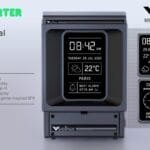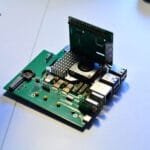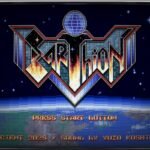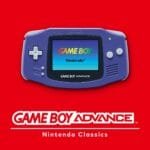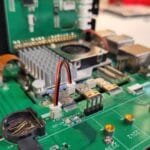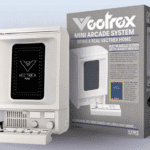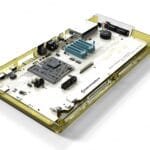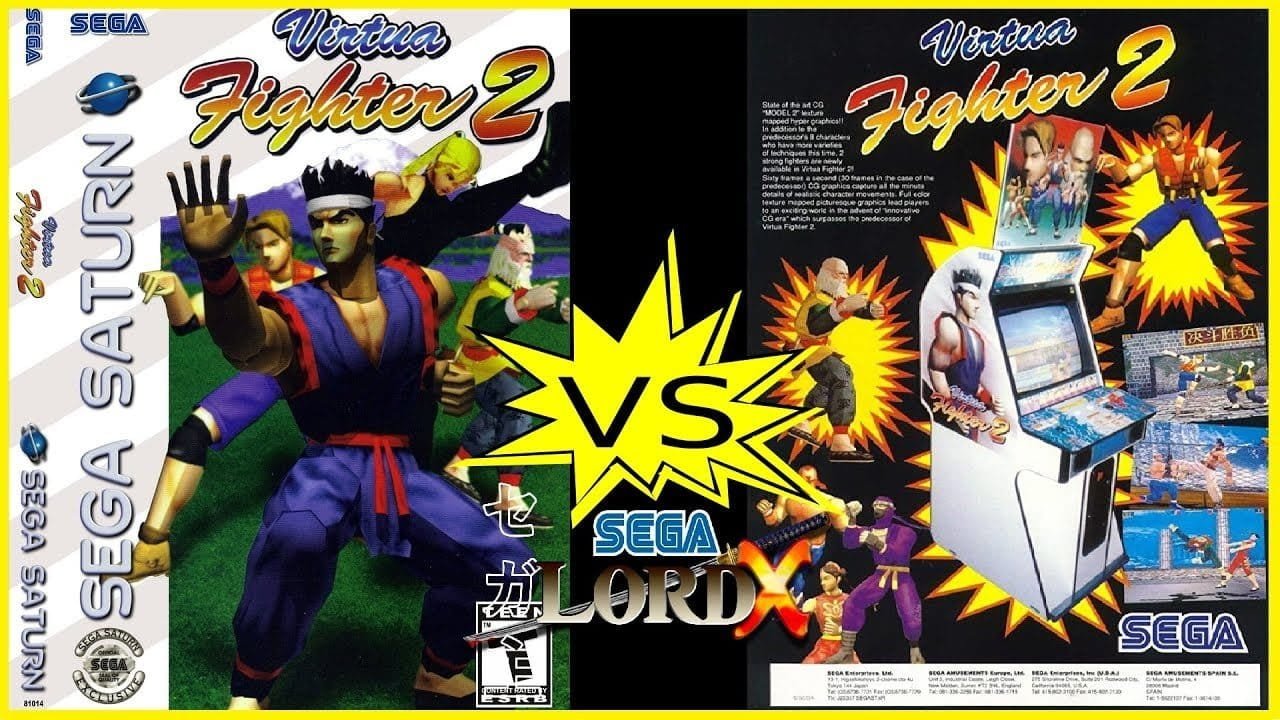John is a former contributor with a collection of interesting retro gaming recollections.
Sega Model 2 arcade games were well regarded, but how did they survive conversion to home consoles?
For every action, an equal and opposite reaction. It might be true, perhaps, and it would certainly be true of Sega’s prickly attempts to port their arcade machines over to the Saturn. Oh, how the pendulum would swing. It was enough to get any Sega fan twitchy over what would become of them, but twitchiness was a state that the Saturn excelled at with its complicated internals and can it, can’t it polygon reliability?
I bought a lot of these conversions at the time and, as I say, pendulous were the swings. I’ll tackle the major ones by year, and PAL releases at that. Let’s start swinging.
1995: Sega Model 2 games head home
Sega had the Saturn out in their home territory for late 1994, but it was a 1995 investment for the rest of us. Virtua Fighter had been a pack-in conversion that came with the machine and had done Sega well in Japan, despite its ageing appearance and less-than-perfect reproduction.

These issues would stand out a lot more by the time the game was thrown in with the Saturn’s American and European release. We had all seen Tekken running on PlayStation by then and that came with texture maps. Virtua Fighter came with cereal box characters and draw distance problems. A messy start and things weren’t going to get better for a little while yet. Daytona USA would see to that.
Daytona was the biggest thing to happen to your local arcade vendor since Street Fighter II and a dead cert for requiring conversion. A blockbuster of a game that introduced most people to the wonders of Sega’s Model 2 hardware. No way this wasn’t going to smash it at home.
To be clear, I, and all the Sega crusty’s like me, find ourselves pulled in two directions with what the Saturn did to this. Rougher than sand paper on the eyes and carrying a frame rate that was at the shiftier end of functional, but it did still play right. It played good even, real chunky good like its forefather. You just didn’t want to see pictures of it next to Ridge Racer on PlayStation. Which was what everyone did see.

So not that great for Sega so far. But somewhere within Sega over Christmas 1994 there had been a meeting, and in that meeting, Sega top brass held their studio heads at gunpoint and issued a warning; if they couldn’t make arcades work at home on Saturn then they were all dead, starting with the underlings, and with enough bullets left over for everyone else.
It would take another year, but that new generation of conversion would come, and when it did that pendulum got exciting.
“Once, twice, three times a lady”
Over the summer of 1995 the Saturn launched in the UK, but already in the press you could see that buying a Saturn was to buy into the future and not the now. Sony’s PlayStation dominated the now, but Sega would follow in kind over the coming winter.

Nothing in pictures looked as crisp and bright as what I saw of the Virtua Fighter 2 demos going into the autumn of 1995. Sega had AM2, the studio behind the arcade game, convert this one in-house, and it was appearing as if they had thrown the technical specifications of the Saturn out of the window. They delivered on it too, and it was the first jewel in Sega’s Big Three assault on wallets leading into the Christmas period. Sega Model 2 stalwarts Virtua Fighter 2, Sega Rally and Virtua Cop, all lined up to be as near-as-stellar as their popular originals.
Sega Rally was the best looking racing game and came with that handling somehow directly lifted over from the steering wheel to digital pad, and Virtua Cop looked sharp and came with the same blue gun. It seemed Sega had pulled it off, and no blood was spilled. Well, they almost pulled it off.
Japan got all three games for Christmas, America did get Virtua Cop and Sega Rally, but outside there you got Virtua Cop if you got anything at all. They had missed windows like poorly thrown rocks, but the pendulum had swung with vigour for what might follow.
Sega Model 2 games on the Saturn
1996 was a busy year for the Saturn. Lots going on in lots of directions, but after a conversion quiet period following a round of sudden success, excitement began to build again with two conversions that I was particularly interested in.

Sega Model 2 game Fighting Vipers was not something that I had seen from my limited access to arcades, but I had thought it looked the business. From the same AM2 team as Virtua Fighter 2 but with a pop-punk attitude and more rough’n’tumble mechanics. Even from pictures, it didn’t look like it was going to be easy to bring home. It was full of lighting effects and armoured layers of polygons.
But by Jove those guys and gals at AM2 did it, or near enough. The resolution was low, but the frame rate high and the lighting still pretty bold for the home market at the time. The pendulum held and AM2 weren’t even done. A Virtua Cop 2 conversion was about to unload itself all over the streets.

We can argue the specific merits of either Virtua Cop over the other on the Saturn, but under a context of conversion, Virtua Cop 2 held the bigger barrel. It was a monster arcade machine, but those crazy fools brought it over in style and even added some extra routes. This was a phenomenal two-player game. Set the pendulum to Virtua Fighter 2 level and someone give those people a raise!
Plus, there was Virtual On. We shouldn’t forget that game, although it was at the time.
Whatever joys were to be converted in 1997, it was going better than alright.
What just happened?
First conversion fruits came early into the new year with Manx TT Superbike, a much awaited game which had come from AM3, makers of Sega Rally Championship. Spirits were high in the Sega cult scene that this would be another winner for the faithful.

Something had changed, though. It was no longer all being done in-house. Tantalus Interactive were handling this one, and they did deliver Manx TT for the Saturn in a serviceable form. But the pendulum loosened and would continue to do so this year with Appaloosa Interactive taking control of Sky Target, a mid-level arcade game which they brought over in middling fashion.
What was going on here? Had Sega bosses put the guns away? I do not know, but you couldn’t help but notice. However, going into the winter were two conversions of internal pedigree. One was very good and one was not.

Those were the days for that sort of thing and in the good camp was brutalist weapons fighter, Last Bronx; hi-res, high frame rate and almost as good as Fighting Vipers. Our bad boy was the surprising disaster that was Sega Touring Cars, an arcade hit machine that seemed a shoo-in for success following Sega Rally. What we got was sub-Daytona. Almost vomit-inducing.
The pendulum, like Sega as a whole, did not know what to do with itself. One final major arcade conversion would follow into 1998, which told us all what Sega had in mind. They were giving up.
Dead on conversion
The House of the Dead had been a right money cruncher for Sega in 1997 and by early spring the next year they already had a home version fit for the bargain bin. I’m not even sure it went on sale at full price.

It certainly shouldn’t have.
Fewer frames per second than could be considered updating and a resolution so low it had to have footings dug for it. Tantalus Interactive had been given the task of bringing over the Sega Model 2 arcade game as fast as possible and they did that. I don’t blame them, it was Sega who let the pendulum fall to a centre weight before kicking it over and leaving it on the floor so they could all go play Dreamcast instead.
But like everything Sega, the good times made it worth it.
Affiliate Disclosure: Some of the links in this post may be affiliate links, which means I may earn a small commission if you make a purchase through those links. This comes at no extra cost to you. Thank you for your support!
John is a former contributor with a collection of interesting retro gaming recollections.
